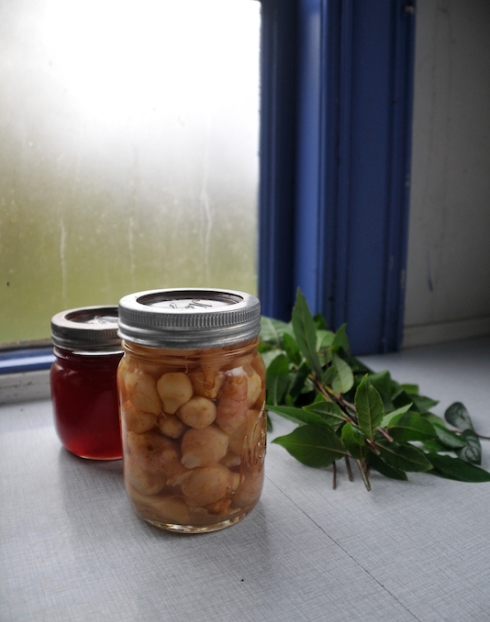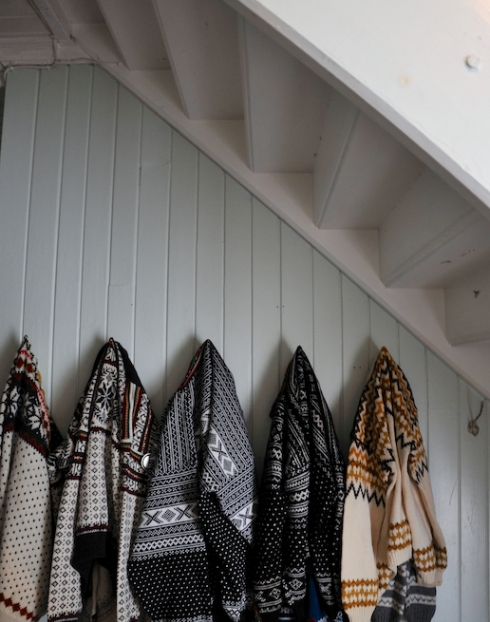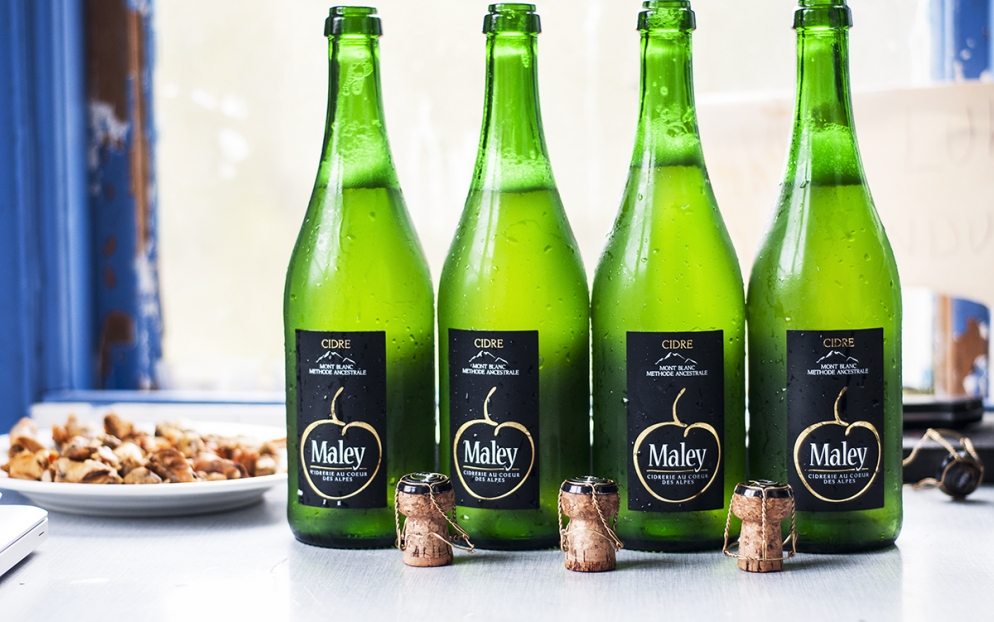Recipe
Mussels with Birch Sap Aspic
Menu:
- Three Variations on Mussels
- Sole Ceviche with Fried Dandelions and Edible Flowers
- Periwinkles with Nettles and Rowanberry Jelly
- Fried Brill with Sea Urchin Butter
- Saddle of Roe Deer with Cured Goose and Pickled Jerusalem Artichokes
- Birch Sap Granita with Syrup of Polypody Root
(All recipes serve 4)
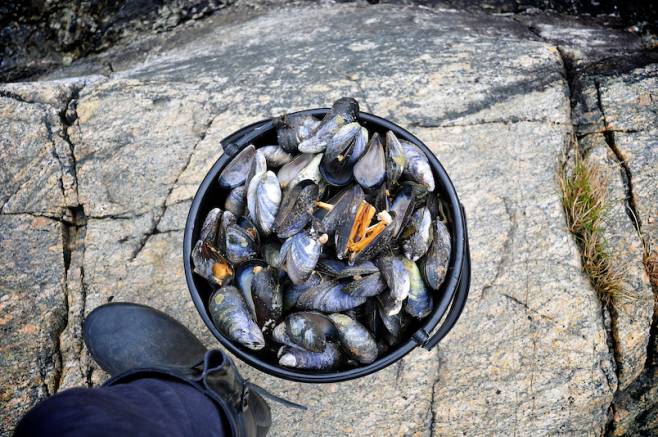
Three Variations on Mussels
For this dish we use birch sap, a slightly sweet, thin syrupy liquid only available for a few weeks in the spring. You gather it by drilling a hole into a birch tree trunk, 2-3 cm deep. Then push a plastic pipe into the hole and strap a plastic bottle to the tree, allowing the sap to drip into the bottle. Make sure to seal the hole afterwards by pushing a bottle cork or a wooden plug into it when you are finished collecting the sap.
This dish combines the fresh flavors of birch and common sorrel with sweet and savory mussels, and a hint of smokiness, and transports your thoughts directly to early summer evenings by the beach bonfire.
- You will need 1.5 kg scrubbed mussels for the three dishes.
You can start by steaming the mussels for all three variations. Check your mussels, if any of them are open just give them a little tap and they should close; if they don’t they’re no good to eat, so throw those ones away. Bring 150 ml of salted water to the boil and add the mussels. Steam on full heat for 4-5 minutes, or until the mussels have opened. If any of them remain closed, throw them away – just to be sure. Cool the mussels down in the refrigerator and remove the meat from the shells.

Pickled Mussels
- One third of the cooked mussels
- 1 tbsp whole black peppercorns
- 3 bay leaves
- Vinegar (7% acidity)
- 4 small glass jars
Sterilize the glass jars and lids by leaving them in boiling water for 10 minutes. Layer the mussels, bay leafs and pepper in the jars. Fill up all the way to the top of the jars with vinegar and some of the cooking liquid from the mussels.
Smoked Mussels
- One third of the cooked mussels
- 2 big juniper twigs
- Sea salt
Place the mussels on a rack. Put the juniper twigs in a big casserole and add a piece of burning wood. Wait until the fire has calmed down, and put the rack with the mussels on top. Put a lid on, and leave to smoke for about 15 minutes.
Mussels with Birch Sap Aspic
- One third of the cooked mussels
- 500 g birch sap
- 20 violets
- 200 g chopped beach onion stems
- 2 gelatin leaves
- 60 g freshly juiced common sorrel
Soak the gelatin in cold water for about ten minutes. Heat 100 ml birch sap until it reaches approx. 80°C, strain the water from the gelatin and stir it into the hot sap. Mix with the rest of the sap and the beach onion, and add the liquid from the common sorrel to taste. Place the mussels on a plate with deep sides, pour the liquid aspic over and spread the violets on top. Leave it to set in the fridge (at 4°C) for at least 8 hours.
Serve the three variations on mussels, and decorate with fresh herbs. We used wood sorrel leaves for the aspic and wild oregano shoots for the smoked mussels.
Sole Ceviche with Fried Dandelions and Edible Flowers
Ceviche is fresh, raw fish marinated in citrus juices. The acid in the citrus coagulates the proteins in the fish, so that it will appear almost as if it is cooked. In this dish we use live ants to create the same process. When ants feel threatened they secrete formic acid, that some say tastes a bit like lemongrass. By placing fillets of sole on top of an anthill, the acid from the ants will magically transform the fillets into ceviche.
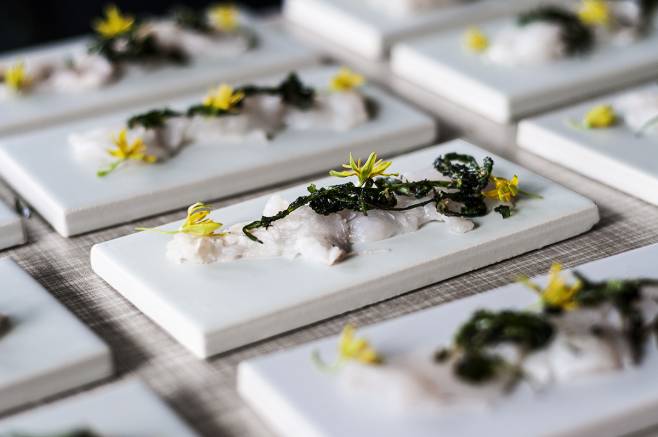
Ceviche
- 500 g fillet of sole
- 200 g edible flowers (we used Yellow-star-of-Bethlehem)
- 1 anthill
Start by freezing the fillets for at least 3 hours, and then defrosting in the fridge before use. This is to make sure there are no parasites in the flesh. Place the defrosted fillets on a clean wooden board. Stir around a little bit in the anthill with a wooden stick, before you place the wooden board with the fish carefully on top of it. Leave the fish on the anthill, and let the ants crawl all over the fish. The acid they secrete will now “cook” the fish, so that the flesh becomes whiter and firmer. This will take about 15 minutes, depending on the number of ants. Clean off the ants, and cut the fish into thin slices.
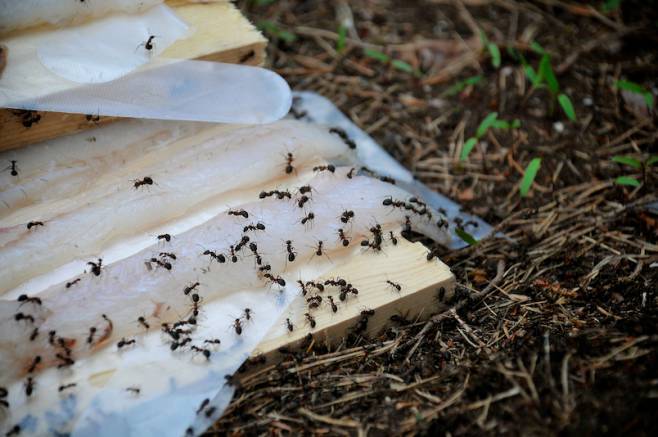
Fried Dandelions
- 200 g leaves of dandelions
- Sea salt
- Canola oil
Heat the oil to approx. 180°C. Make sure the dandelion leaves are dried off and fry them until they turn dark green. Leave to drain on a kitchen cloth, and season with a bit of sea salt.
Serve the thin slices of ceviche with the crisp dandelions on top, and decorate with edible flowers. Add a pinch of sea salt if needed.
Periwinkles with Nettles and Rowanberry Jelly
Periwinkles are the snails of the sea, and you can find them on big rocks at the seashore, often hiding under the seaweed. It may come in handy to bring a small knife, if you need to cut them loose. Unlike mussels, they are not sensitive to algae, and are therefore safe to eat all year around. Their taste is mild and slightly sweet, with a salty hint of the sea. This dish combines the earthy, aromatic taste of nettles and sweet and tart rowanberry with the periwinkles in a great and simple way, allowing the flavours to really shine.
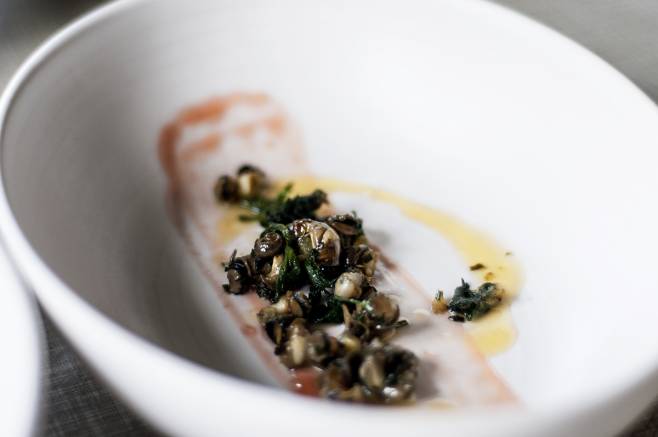
Rowanberry Jelly
- 200 g rowanberries
- 150 g brown sugar
- 150 g common sorrel
- 75 g white wine
Boil the berries in the wine for about 15 minutes. Add the sugar and the sorrel and stir a bit until the sugar dissolves. Strain the mixture through a fine mesh sieve, and let it reduce for 5 minutes more. Leave it to set in the fridge (at about 4°C) for at least 1 hour.
Periwinkles with Nettles
- 500 g periwinkles
- 500 g stinging nettles
- 200 g beach onion
- 300 g fish stock
- 100 g butter
- 75 g white wine
Fry 100 g beach onion in 50 g butter until it starts to color. Add the periwinkles and fry for 8 minutes. Add 75 g white wine and the fish stock, and let it simmer for about 2 minutes. Strain off the broth, and keep it for later. Using a toothpick or a pin, pull the meat out of the shells, making sure to remove the small digestive tract.
Bring salted water to a boil, and blanche the nettles in the water for 2 minutes, before straining it. Finely chop the rest of the beach onion, and fry the onion, the nettles and the rest of the butter for about 2 minutes. Serve the periwinkles hot with some of the broth and some rowanberry jelly on top.
Fried Brill with Sea Urchin Butter
Sea urchin has for a long time been a delicacy in Asia, but has quite recently been discovered in Norwegian cuisine. Sea urchins eat pretty much anything they come across, and in some areas they have become a threat to the kelp forest, as well as other species. Eating them is, in other words, not just a delicious experience but also a help to the environment!
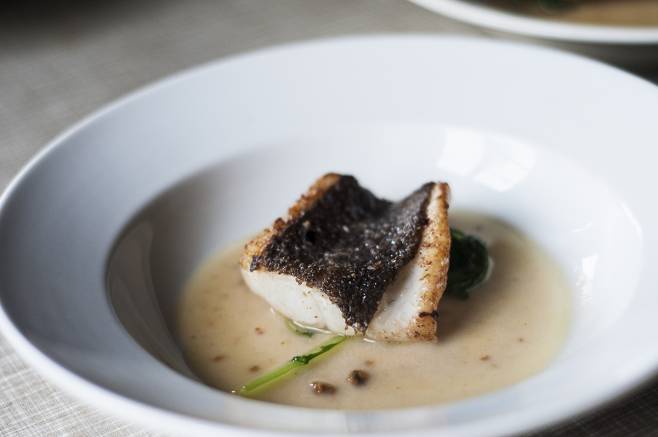
- 500 g fillet of brill, with skin on
- 150 g sea urchin roes
- 150 g fish stock
- 50 g butter
- 150 g common sorrel
- 150 g beach onion
- Butter for frying the fish
Start by mashing the sorrel, onion and sea urchin roes with a mortar and pestle until it becomes a smooth purée. Melt 50 g of butter in a frying pan, add the purée, and let it simmer for a minute. Stir in the fish stock, and let simmer for two more minutes. Cut the brill fillet into nice serving-sized pieces. Fry the fillets on the skin side in butter until it turns golden brown, while basting with the butter. The fish is done when the meat has turned white and firm. Pour over the sea urchin sauce and serve immediately.
Saddle of Roe Deer with Cured Goose and Pickled Jerusalem Artichokes
The pickled Jerusalem artichokes require that you start planning this dish a couple of weeks in advance. If you don’t have the time for this, you can bake them in the oven instead, or prepare them the way you prefer. With that said, the balance between the sweet, savory and acidic components you get using the pickled Jerusalem artichokes is what makes this dish absolutely divine.

Pickled Jerusalem Artichokes
- 200 g Jerusalem artichokes
- 100 ml water
- 150 ml vinegar
- 15 g sugar
- 15 g salt
Peel the Jerusalem artichokes and boil them in lightly salted water until they are almost cooked. Boil up 100 ml water and the vinegar, and stir in the sugar and the salt. Pour this brine over the artichokes and keep in an airtight container for at least two weeks before serving.
Cured Goose
- 200 g goose breast
- 100 g sugar
- 100 g salt
Mix the sugar and salt, and cover the goose with the mixture. Place in the fridge for 12 hours. Wash the mixture off and dry off the goose breasts with kitchen paper. Cut into thin slices.
Roe Deer and Sauce
- 500 g saddle of roe deer
- 300 g beach onions
- 150 g roe deer stock
- 60 g brown sugar
- 150 g red wine
- Butter for frying
- Sea salt
Cut the meat into 125 g pieces and season with salt. Brown the meat and the onion in a frying pan in butter, for about 4 minutes on each side. Let the meat rest for 10 minutes. Heat the sugar in a pan until it turns dark brown. Add the wine and let it reduce a bit, pour in the stock and let it reduce to the desired consistency. Place slices of the roe deer, thin slices of goose, the Jerusalem artichokes and the beach onion on a plate, pour over the sauce and serve.
Birch Sap granita with Syrup of Polypody Root
Polypody root is the stem of the polypody fern, which can be found in most parts of Norway. It tastes sweet with slight notes of liquorice, and has been valued for centuries, both for its deliciousness as well as its medicinal properties. This dessert is a refreshing and light end to the meal, assuring that you are ready to enjoy the rest of the long, bright summer’s night.

Granita
- 250 g birch sap
Freeze the birch sap for at least 3 hours, occasionally stirring it with a fork to form small flaky pieces of ice as it freezes.
Syrup
- 50 g birch sap
- 200 g common sorrel
- 300 g cleaned polypody root
- 85 g brown sugar
Boil the polypody root, the common sorrel, the sugar and the birch sap until it reaches a syrupy consistency. Strain the syrup and let it cool down slightly. Serve the granita in frozen bowls, and drizzle the syrup on top.
For a full review of the Flo & Fjære event held on the island of Håøya, please see here.
Text: Francisca Witsø
Recipes: Magnus Morveto
Photos: Christoffer Johannesen and Megan Guertner
